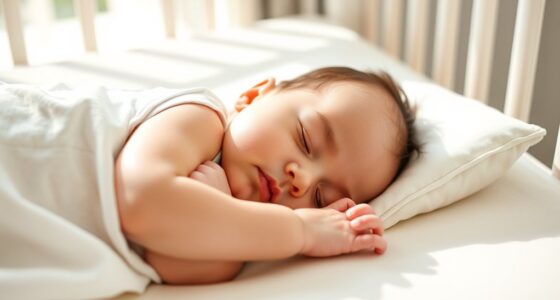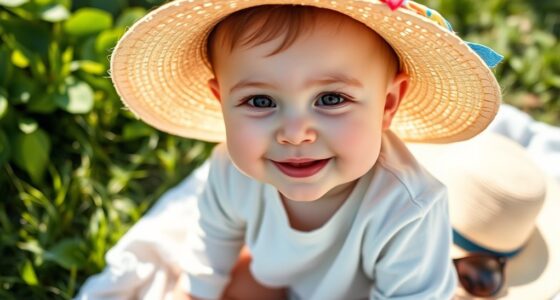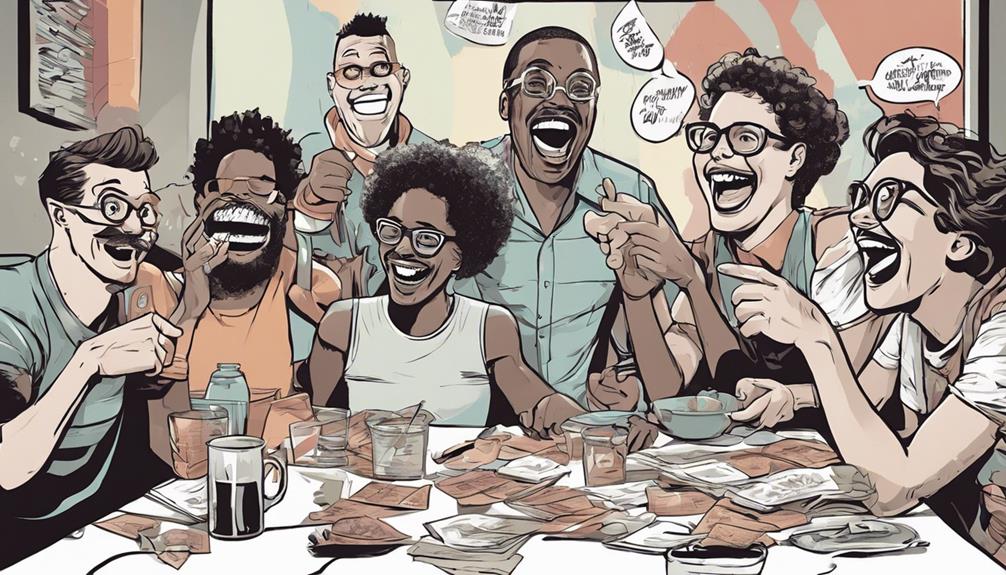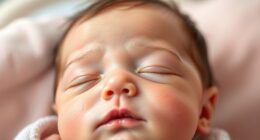To keep your baby’s pacifier germ-free, regularly clean it by rinsing off dirt and sterilize it by boiling, microwaving, or using dishwasher-safe sterilizers as per manufacturer instructions. Avoid harsh chemicals and store it in a clean, dry container or sanitized clip when not in use. Replace worn or damaged pacifiers promptly. Proper hygiene is crucial, and following these safe practices helps protect your baby from germs—discover more tips to guarantee extra safety.
Key Takeaways
- Rinse and sterilize pacifiers regularly using boiling, microwave sterilizer, or dishwasher safe methods; avoid harsh chemicals.
- Store pacifiers in a clean, dry container away from germs, pets, and contaminated surfaces.
- Replace pacifiers promptly if damaged, cracked, or worn to prevent bacterial buildup.
- Clean pacifiers immediately after falls or contact with the ground, following the five-second rule cautiously.
- Follow manufacturer instructions for safe sterilization and avoid using chemical cleaners not designed for baby products.
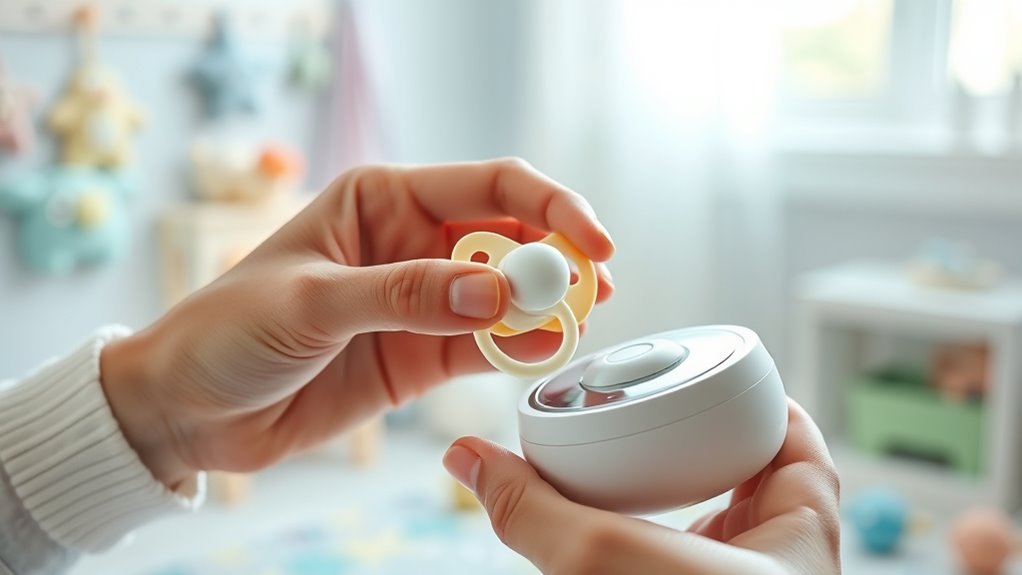
Have you ever wondered if your baby’s pacifier is as clean as it should be? It’s a common concern, especially since pacifiers often end up in your little one’s mouth multiple times a day. Keeping it hygienic isn’t just about appearances; it’s about protecting your baby from germs and potential infections. To do this effectively, you need to understand proper cleaning techniques and storage safety. Proper cleaning techniques involve more than just rinsing with water. You should regularly sterilize the pacifier by boiling it in water for five minutes or using a microwave sterilizer designed for baby items. Some pacifiers are dishwasher safe—just check the label—but avoid using harsh chemicals or cleaning agents that aren’t specifically made for baby products. When cleaning, focus on removing any visible dirt or debris, but remember that bacteria can linger even after the pacifier appears clean. So, a thorough sterilization process is essential, especially if your baby is sick or has a weak immune system. Additionally, maintaining indoor air quality by regularly cleaning and ventilating your home can help reduce airborne germs that might settle on the pacifier or other baby items. Storage safety is equally important. Always keep the pacifier in a clean, dry container when not in use. Avoid leaving it exposed on surfaces that could harbor germs, like countertops or changing tables. Instead, use a dedicated, ventilated container or a pacifier clip with a sanitized cover. This minimizes the risk of contamination from dirt, dust, or germs lurking in the environment. Never store the pacifier in a place that has been exposed to pet hair or other potential sources of bacteria. Also, make sure to replace the pacifier regularly, especially if it shows signs of wear or damage, as cracks or tears can harbor bacteria and compromise safety. If the pacifier falls on the ground, follow the “five-second rule” with caution; it’s better to clean and sterilize it before giving it back to your baby than risking germs from the floor.
Frequently Asked Questions
How Often Should I Replace My Baby’S Pacifier?
You should replace your baby’s pacifier regularly to guarantee safety. The pacifier lifespan varies, but a good rule is to follow a consistent replacement schedule. Check for signs of wear, cracks, or damage often, and replace it immediately if you notice any issues. Generally, replacing it every 4 to 6 weeks helps prevent germs and keeps your baby safe. Regular replacement is key to maintaining a hygienic and safe pacifier.
Can I Sterilize Pacifiers in the Microwave?
Oh, sure, microwave sterilization sounds high-tech, but it’s not a magic cure-all. You can sterilize pacifiers in the microwave, but only if you’re careful. Use a microwave-safe container and avoid overheating, which can damage the pacifier. Remember, proper pacifier cleaning includes regular washing and sterilizing, but always follow manufacturer instructions. This way, you keep germs at bay without turning your kitchen into a science lab.
Are Certain Materials More Hygienic for Pacifiers?
When choosing a pacifier, you wonder if certain materials are more hygienic. You should look for pacifiers made from high-quality, BPA-free silicone or latex, as these materials are safe and easy to clean. A hygienic design with minimal crevices helps prevent bacteria buildup. Prioritize pacifiers that are durable and simple to sterilize, ensuring they stay safe for your baby’s use. Always follow manufacturer guidelines for proper cleaning and sterilization.
Is It Safe to Share Pacifiers Between Siblings?
Sharing pacifiers between siblings isn’t safe because it increases the risk of cross contamination. You might think it’s harmless, but germs and bacteria can easily transfer from one child to another. To keep everyone healthy, avoid sibling sharing and have each child use their own pacifier. This simple step helps prevent the spread of infections and keeps your little ones safer and healthier overall.
How Do I Prevent My Baby From Sucking on Dirty Objects?
To prevent your baby from sucking on dirty objects, keep a close eye on what they reach for. Offer teething relief options like safe pacifier accessories or chilled teething rings to soothe discomfort. Regularly clean and inspect pacifiers, replacing worn ones promptly. Encourage your baby to use their pacifier instead of random objects, and teach them to avoid putting unclean items in their mouth. Your attentiveness keeps germs at bay and supports healthy teething habits.
Conclusion
Keeping your baby’s pacifier clean is essential for their health. Regularly sterilize it and avoid sharing to prevent germs. Did you know that babies can pick up about 2 to 3 colds a year from unclean pacifiers? By following these simple do’s and don’ts, you minimize their exposure and keep your little one safe. Stay vigilant, and your baby will stay healthier and happier.



